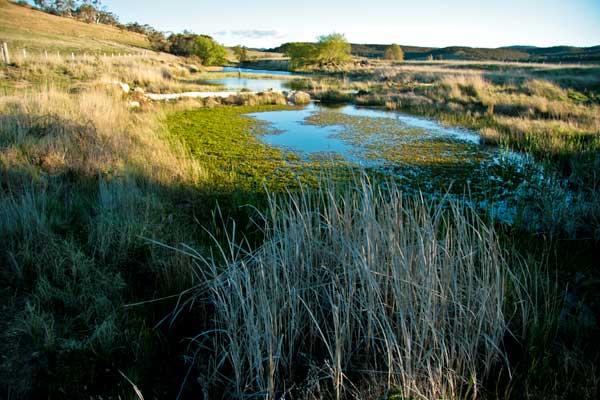Rehydrating the Landscape
One of the longer format documentary we are currently working on is to look at the nature of river systems in Australia and how in this dry continent functions in hydrating the landscape. Mulloon Creek Natural Farms near Canberra is home to Tony Coote who has attempted a unique experiment on his farm. Seeing the spectacular results obtained in clover yields on a neighours farm, Tony has turned his farm over to Biodynamics.
But he’s also gone a lot further by also looking at how he can improve the water flow in the creek that runs through his property. Natural Sequence Farming is the invention of Peter Andrews who has been extensively featured in a number of short documentaries on ABCTV’s “Australian Story.” The theory as Tony Coote explains is that Australia’s river system were heavily overgrazed by cattle and sheep and the hard-hoofed animals have effectively destroyed the surrounding creek beds by cutting erosion channels and gullies that in a downpour of rain have further eroded the creek bed and washed away a lot of fertile topsoil. Over the years the river bed drops deeper and deeper.
[youtube]http://www.youtube.com/watch?v=jFV9J9pwjgc&feature=player_embedded[/youtube]
The underground water level drops further and further. The surface soil get dryer.The problem according to Tony Coote is that we don’t have a river systems like they do in Europe, fed by glacial and seasonal melting ice but rivers that have turned into gutters or channels in this country. Channels that wash away the top soil and any fertility away to the sea. But it wasn’t always like that. Australia and Nature had a way with dealing with water and the answer is revealed in this documentary.
Here’s the first 10 minutes under the working title of “Rehydrating the Landscape” it will look at the work of Peter Andrews and Geoff Lawton. Whilst Peter works on the river system to return fertility to the lowlands, Geoff Lawton from the Permaculture Research Institute tackles the hill country by building a series of swales or water harvesting ditches on contour that snake around the high ground, soaking rain water and feeding underground aquifers. Thousand of trees both fruiting and non fruiting mulch trees are planted on the swales to create a mini food forest that will bring fertility and life back to the area and make it a showroom of sensible and sustainable design.







Brilliant work! I have creeks nearby with similar deep erosion and sheer banks, mostly caused by runoff from paddocks over-cleared for cropping. I want all my neighbours to see this video.